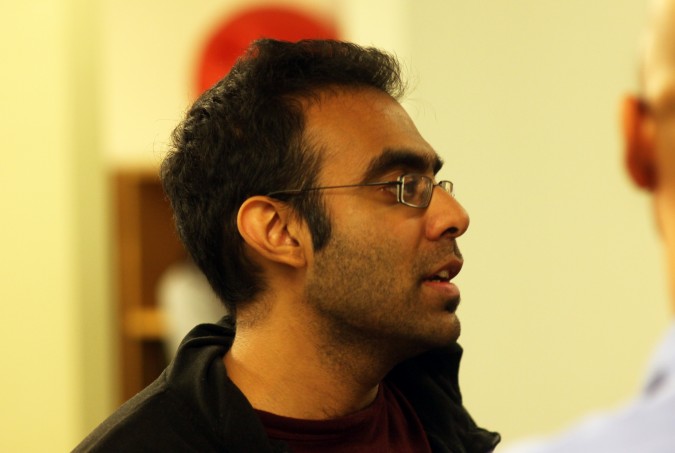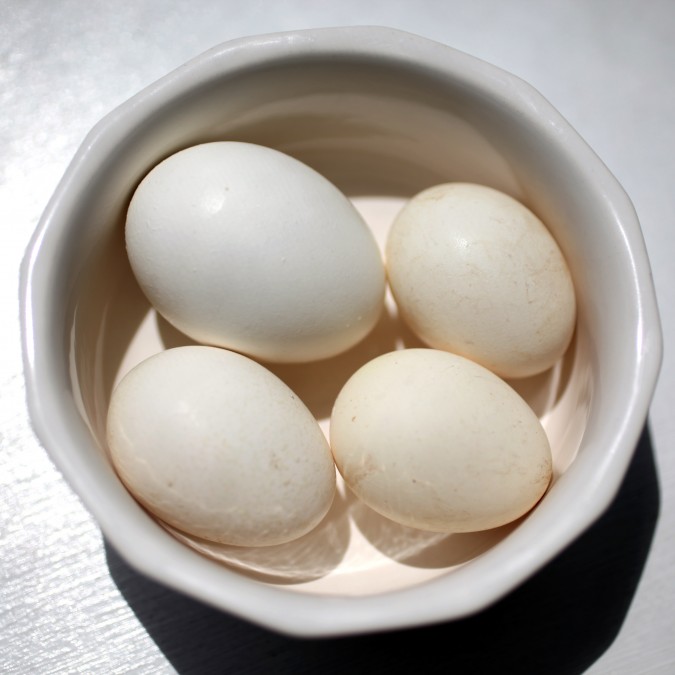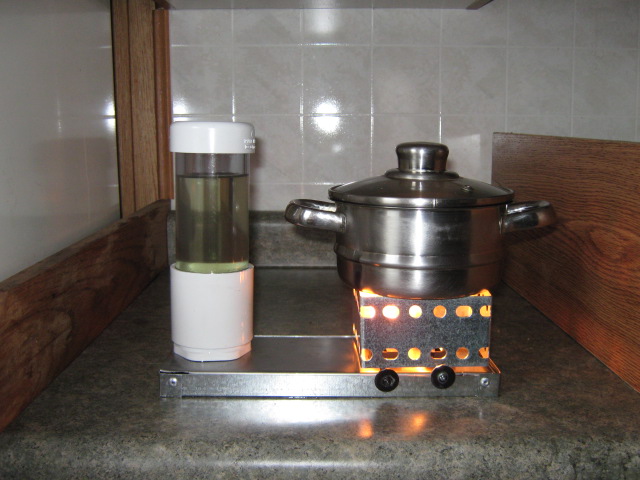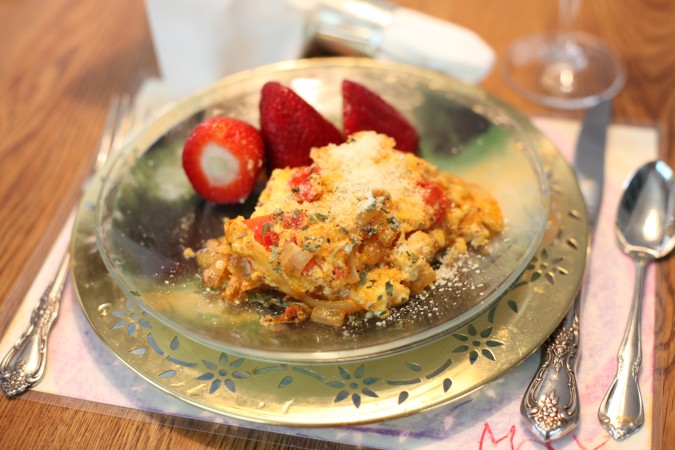Archive for the ‘Cooking’ Category
Food Startups panel discussion at SOMA Central in San Francisco
On Wednesday, November 16, 2011 I attended a fascinating panel discussion entitled Food Startups. To learn more about Food Startups, follow @foodstartups on Twitter.
The panelists were:
- Rob LaFave, Founder and CEO of Foodzie
- Nikhil Arora, Founder of Back to the Roots
- Alexa Andrzejewski, Founder and CEO of Foodspotting
- Rajat Suri, Founder and CEO of E la Carte
- Nate Gallon, Partner at Wilson Sonsini Goodrich & Rosati, PC
- Ananda Neil, Founder of Artisan Growers and Producers
The moderator was Wade Roush, Chief Correspondent at Xconomy and Editor of Xconomy San Francisco.
Food Startups was organized by my friend Matthew Wise, who invited me. Wise is a busy man — he’s running two startups — FounderLY and TableSlice.
Wade Roush was the moderator.
Wade Roush was a staff member at MIT’s Technology Review (a very good magazine my father gave me a subscription to for my birthday on October 6th), serving multiple roles, including senior editor, San Francisco bureau chief and executive editor of the magazine’s TechnologyReview online presence. Roush was also the Boston bureau reporter for Science magazine and managing editor of supercomputer publications at NASA Ames Research Center. Roush graduated with honors in the history of science from Harvard University and earned a PhD in the history of science and technology from MIT.
Wise gathered a panel that is the equal of panels I’ve seen at the MIT Venture Lab series held at Stanford University. In other words, simply outstanding.
I captured the entire panel discussion to video, and I have embedded it here.

Nate Gallon, partner at Wilson Sonsini Goodrich & Rosati, and Matthew Wise, Food Startups organizer, November 16, 2011
Since the video is available, I will reserve my written remarks for the most entertaining highlights of the evening.
The most remarkable startup story was that of Nikhil Arora. Arora founded a food company that is brilliant. It’s called Back to the Roots. Their product is mostly recycled trash I presume they either get for free or are paid to take away. Sounds unappealing you say? It’s not. Back to the Roots gathers tons and tons of used coffee grounds from San Francisco Bay Area coffee shops and resells the grounds to consumers for about USD $8.00 a pound.
That’s not much less than the coffee cost before it was earlier flooded with hot water to make coffee.
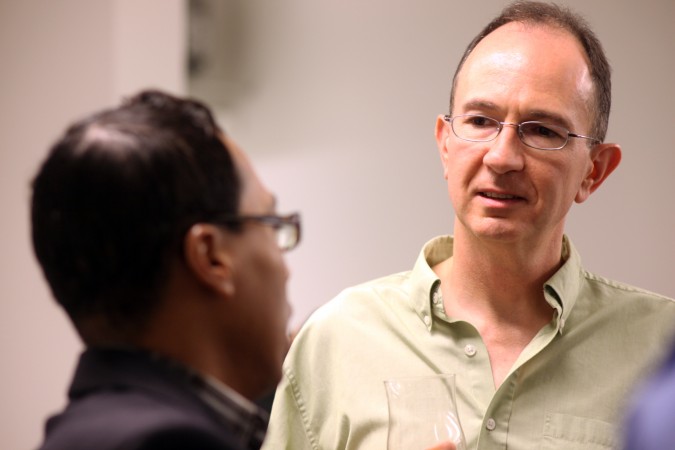
Matthew Wise, Food Startups organizer, and Wade Roush, Chief Correspondent at Xconomy and Editor of Xconomy San Francisco. November 16, 2011.
The secret sauce is that Back to the Roots adds mycelia to the coffee grounds and then boxes up what others consider trash in attractive boxes that when opened form the container for the buyer’s mini mushroom farm.
The farm is started by opening the box and misting the grounds with water from a tiny 1 ounce spray bottle that’s included with the kit. After misting twice a day for 10 days, the first harvest is ready, and one box can be harvested multiple times until a pound and a half of oyster mushrooms have been picked. Then the unbleached cardboard box and the grounds can be recycled. Genius.
The founder is a Haas School of Business graduate that knew nothing about the food business when he started in 2009. His company now operates a 10,000 square foot warehouse and his mushroom growing kits are for sale at Whole Foods Markets and Home Depot. Those are two customers not frequently paired in the same sentence.
Arora had the approximately 50 people in attendance enthralled when he described an early sales visit to a Whole Foods Market grocery store. Without an appointment, he brought in a plastic bucket of used coffee grounds and somehow captured the attention of the rank-and-file worker (whoops… associate) he first walked up to. He was ushered in to meet with a manager and an order flowed from that bold move. I found it to be an inspiring and moving story.
This Food Startups event was sponsored by:
- Artisan Growers and Producers
- Six Finger Films
- Tony Chen Productions
- FounderLY
The stories of the other panelists were fascinating as well. Please watch the video. I’m sorry I don’t have the time to write detailed summaries of the other fine and worthy companies.
Entrepreneurs are rewarded for being bold and outrageous.
Read about Justin Yoshimura of 500friends for another example.
Here’s what Steve Newcomb of Founder School says about Yoshimura:
“I thought I had met some tenacious people in my life, but Justin is ridiculous. In some super weird, proud way, he reminds of some little mangy dog that bites your leg and just won’t let go. If Justin decides he’s going to do something, he’s going to do it, no matter how scrappy he needs to be to get the job done. Keep going you scrappy little dog… make us proud.”
Another bold and outrageous entrepreneur sadly passed away recently, and this seems a fine place to focus additional attention on his remarkable life.
Andreas (Andy) Sæbjørnsen is the co-founder of the two startups Matthew Wise is working on, FounderLY and TableSlice.
I took all the pictures and video for this and posted the pictures at full 21 megapixel resolution. Click on the pictures to see the full size versions.
While I was researching Nikhil Arora for this post, I discovered his TEDx appearance where he talks about his urban mushroom farming enterprise Back to the Roots. I embed the video of the talk below, since I think it’s worth watching. Enjoy.
If you enjoy my posts, please share them on Facebook or Twitter. Also, please consider subscribing by filling in your email address in the box in the upper right corner of this page.If you want to use the pictures from this site, I’ll probably let you, so just ask.
Additionally, I want to become a public speaker and guest columnist. If you have an opportunity to offer for either, I’d love to hear from you. You can find me on Facebook and Twitter.
Finally, please leave a comment and friend me on Facebook if what I write resonates with you. Thanks!
Cooking chicken eggs from my urban homestead for the first time
This morning I fried 3 of the 7 eggs my backyard chickens have produced since August 12, 2011 for my urban homesteading household.
I live right in the center of bustling San Francisco, California USA, so this is particularly exciting. A couple of years ago I had no idea I would be farming! My cousin Cindy Christensen owns a farm, and I’ve marveled at her wide array of award winning show chickens she raises. But even when I was visiting her farm, I never considered that I would one day soon be feeding chickens and collecting eggs each morning.
The eggs my chickens have produced so far are smaller than the smallest eggs for sale at any grocery store I’ve visited.
I shot the video of me cracking these first eggs into a stainless steel pan so the background would be a light color. Normally I wouldn’t fry eggs in this pan.
Maybe it was the excitement of raising these chickens from when they were just 3 days old, but these fried eggs were the best I’ve had.
Have a look at how orange the yoke in the upper left is. I was expecting all the eggs to have yokes that color. Food writer extraordinaire Michael Pollan educated me through his book The Omnivore’s Dilemma that good eggs should have orange yokes, not yellow yokes. I am now a believer and I am certain I can taste the difference.
I shot the video above in full 1920 x 780 high definition video on my Canon EOS 5D Mark II camera.
Chinese cooking like you’ve never seen before
I show people how to cook on my fledgling online cooking show.
I use one burner and one wok.
Here’s an entertaining video where one cook uses many burners and woks at once. His intense wok handling makes me think of Carl Palmer of Emerson Lake & Palmer. ELP has a huge drum kit, and Palmer goes nuts on these drums.
I have no idea if the food this chef is preparing is any good, but I did find this video of him strangely fascinating.
Don’t look to my cooking show for instruction on how to cook like this guy. My cooking set would be too hot to remain on if I had that many serious wok burners going at once. My burner is just 12,000 btus. The cook in this video appears to be using hundreds of thousands of btus in total. I bet he’s tired when he goes home.
One of the commenters on this video counted that this cook is performing two operations per second. Enjoy.
BioLite stove charges cell phone while cooking
This BioLite brand stove produces a tiny amount of electricity that is enough to charge a cell phone or run an LED light.
About five years ago I was a judge for the business plan competition at the Center for Entrepreneurship and Technology at the University of California at Berkeley.
The winning team had a technology that would produce electricity when placed into a flame. Their plan was to sell in the developing world a product for about USD $10.00 that cooks could use to charge their cell phones. I don’t know what became of that company, or if the BioLite stove uses the same technology.
I had a long talk with the founder of the company at Berkeley both before and after the winners were announced. I recall that the technology was developed at Lawrence Berkeley National Laboratory. I was pleased with myself because I predicted this team would win, and they did.
I learned about the BioLite stove on TechCrunch, an AOL blog that covers the technology industry.
Vegetable oil fueled cooking stove
I subscribe to the Tiny House Blog mailing list. This is perhaps my favorite blog email list. How the authors of this site can come up with interesting tiny houses to write about everyday I don’t know.
Sometimes Tiny House Blog writes about appliances that make sense in a tiny home, such as the Lodge-Tech vegetable oil fueled cooking stove.
Lodge-Tech vegetable oil stoves run on pure vegetable oil, not biodiesel or diesel. That means you can fuel your stove from the same bottle of oil you use to cook with. This means no stinky diesel fuel in your living space, which is more important if your cooking area is close to your sleeping area.
I am ordering one of these vegetable oil stoves for my online cooking show. I will use it to prepare rice and to keep food warm on set. I will also use it to demonstrate that alternative fuels work and have merit. I would think vegetable oil stoves would be very useful in many settings, particularly camping settings, where carrying propane, white gas or diesel fuel is undesirable.
These vegetable oil stoves are affordable at just USD $49.00 including shipping. I will conduct a thorough test and take photographs and video to post here with my written reactions to this unique stove.
Teaching cooking in school by having students prepare lunch daily for the entire student population
Around the breakfast table this morning in Tigard, Oregon, at the home of my 99 year old grandmother Elsie Battaglia, I had a good conversation with Claudia.
Claudia is a school teacher, and only recently put her profession on hold to take care of my grandmother full time.
Claudia and I had an animated conversation about teaching children to cook. I wondered aloud if perhaps the best way to teach children to cook would be to have the students cook lunch daily for the student body. Instead of employing kitchen staff, schools could employ cooking teachers that would teach and supervise students who would do the actual cooking and serving.
The teaching opportunities would be varied and numerous:
- Nutrition
- Meal planning
- Accounting
- Budgeting
- Cleaning
- Customer service
- Math
- Growing
- Purchasing
- Cooking
School kitchens already have certified cooking and food preparation appliances, and by turning the kitchen into a classroom for use throughout the school day, the classroom area of the school is automatically increased at zero or small cost.
Claudia thought my idea is worthwhile. She has dozens of ideas she wants to pursue to increase the quality of education. She hopes to open her own small school, where she can implement many of her ideas. I encouraged her to start a blog to write about her ideas to make friends with likeminded readers. She said she’s been wanted to set up a blog for a while now, and asked me to help her set up her blog during my current visit. Of course I agreed, and that’s on our agenda.
Certainly there is a risk if students are charged with cooking for their classmates. Someone might poison the food, for example. But, to my knowledge, prisoners cook for fellow inmates, and I haven’t heard of poisonings happening in that context.
I would think that daily cooking for classmates would help students feel connected to their classmates to such a degree that poisonings would be quite rare. Something is clearly wrong in US schools — so wrong that students are regularly shooting their classmates and instructors with guns. I wonder if cooking for classmates might reduce school shootings by helping students feel more connected to and empathetic towards their fellow students.
The advantages to having every student know how to cook for themselves and for a crowd I believe would strongly outweigh any possible dangers from accidental or intentional kitchen related incidents.
The way the system works in the US now is millions of students can’t cook a healthy, delicious and balanced meal when they graduate. As a result, they rely on corporations to cook for them. The Omnivores Dilemma by Michael Pollan details the many horrors that result when corporations cook food to feed a populace.
When corporations cook for people, health suffers and people get sick and die. The number of people that get sick from eating corporate food is likely orders of magnitude higher than the numbers of students that perhaps might get sick by eating student prepared food.
Society should be able to accept a potential small incremental risk to the immediate safety of school lunches in exchange for a dramatic improvement in food safety long term by the population turning away from corporate food in favor of home cooked healthy and delectable meals.
The gold standard even today for desirable food is a ‘home cooked meal.’ Why aren’t we teaching the entire population how to prepare a great home cooked meal? It is unfortunate that cooking isn’t a required class each year of school. With my plan, described here, to turn school kitchens into classrooms, and to turn students into trained cooks and kitchen managers, adding 12 years of cooking classes to every K-12 educational system in the country doesn’t have to cost extra, and the dividends society will reap are potentially shockingly dramatic.
I predict that a rigorous analysis of my plan will show that the lifecycle cost benefit to my plan will total trillions of dollars per generation, as the health care costs to treat the illnesses associated with poor diet will likely be shown to dwarf any direct costs associated with turning school kitchens into cooking and management classrooms.
Many others are advocating for healthy school lunches. Here are some links:
- High School Students Bring Healthy School Lunch to DC – and Cook with White House Chef Sam Kass
- Two schools grow, cook food in lunch partnership
- Healthy School Lunches
- Students Will Cook Their Lunch and Eat It, Too
I predict a firestorm of protest from various powerful unions if they were to seriously consider adopting what I write above. The existing school lunch cooks would probably not have teaching credentials, so the teachers’ unions would probably not want them to become teachers. I also suspect the existing lunch staff would not want to teach hundreds or thousands of students how to do their jobs.
I don’t know what type of person would be best suited to the position of cooking teacher, but I am nearly certain there would be many applicants for a job like I’ve outlined above. I think a special type of person is needed — someone who is passionate about food and nutrition and teaching, yet can handle the daily grind of operating what amounts to a busy commercial kitchen with student workers.
I am passionate about teaching people to cook. I created and published my first cooking show in January. I sadly haven’t published follow on episodes yet, but I remain committed to publishing 11 more shows this year.
I cooked rabbit for the first time
I have ordered rabbit occasionally from restaurant menus. I’ve enjoyed eating rabbit, but I never have cooked it.
I shop for meat at Guerra Meats at 490 Taraval Street in San Francisco, California, where I live. This charming store was opened by Mark and Battista Guerra in 1954, and I often hear the butchers greet their customers by name.
On March 28, 2011 when I was shopping there for boneless chicken breast, I saw that a full rabbit only cost $1 more per pound. I purchased the rabbit and the butcher cut it up on a floor mounted serious looking band saw with no blade guard protecting the 12 inches of exposed blade. His fingers were quite close to that blade as he made about 10 cuts in short order. I cringed watching him work as I am so much more careful when working around power tools, and my neighbor told me a story only weeks ago where a butcher friend of his was cutting frozen meat on a band saw and cut a handful of fingers off and didn’t know it because his hands were so numb from the cold. His coworkers alerted him when they saw blood everywhere. Ouch!
Yesterday, March 29, 2011, I made two meals from the rabbit. I cut off about 4 ounces of meat and made one of my Chinese recipes, with snow peas, mushrooms, zuchinni, onions and red bell pepper. The result was delicious. Rabbit is close in taste to chicken. It’s a bit more substantial I found.
Later, I fried the remaining rabbit as if I were making fried chicken. This was even better than the Chinese dish. I found the rabbit to be more flavorful than chicken, so much so that it really was finger licking good. It was scrumptious.
Now I’m wondering if I could ever bring myself to raise rabbits for meat. The book Urban Homesteading that inspired me to try urban homesteading makes it sound easy. Rabbits are so cute and cuddly I don’t know if I could ever kill one to eat.
Have any of my readers killed a rabbit, duck, chicken or quail for food to eat personally? If so, please write a comment describing how it felt and how difficult it is.
Cooking lessons with Kevin Warnock – episode #1
I promised my readers on January 2, 2011 that I would start an educational online cooking show by February 2011. I am happy to report that I created the first episode two days ago and I edited the video and uploaded the result today, 1/11/11.
As a side note, I started my company Silveroffice, Inc. 3/3/03, and on 6/6/06 I offered to give my domain gOffice.com to Google, Inc. for their use in branding what is known now as Google Apps. Google didn’t take me up on my offer, thank goodness, as I continue to use the domain for Silveroffice.
I plan to regularly release episodes of my cooking show, which I’m titling for now ‘Cooking Lessons With Kevin Warnock’.
I have a brand new and very photogenic temporary video production set I built in my garage. It’s sparkling new, and has never before been used for anything. I am proud of building this studio, as I had to learn new skills. For example, I personally cut the hole for the sink in the granite counter top. I also installed the granite counter tops and the cabinets and all the other appliances. This space looks like a real kitchen, but it’s not because there is no stove or oven yet. Originally the plan was to install one before I learned San Francisco doesn’t permit two stoves in a single family house. However, there is an exception for moving image production facilities, and I am using that exemption to bring you this cooking class series. Because of the exemption, I could install a permanent stove, but for now I will not, because a portable catering butane burner will work better from an aesthetics perspective, because I can place it right in front of the video camera and I can thus face the camera directly. If I had a normal range, the camera would need to be to my side, which would make it difficult to see what I’m doing.
I don’t store food on set, and I never use the set for personal cooking. I do all my cooking for sustenance in my real kitchen upstairs in the living area of my house. I welcome a visit at any time by San Francisco building inspectors to verify this claim, as I don’t want any trouble from the City. I don’t even have the refrigerator running except when I’m actively producing a video, to save electricity. An inspection will turn up a legitimate video set, not an illegal second kitchen. You can see in today’s video when I tried to use the microwave that I had to remove the instruction book from the oven, as I had never used it to heat food until this video.
I prepared this first episode using my camping propane burner. I didn’t know there are butane indoor safe burners that have enough heat output to cook Chinese food when I shot this video. Now that I know, I will be ordering the proper butane burner for future episodes. Please don’t use a propane camp stove indoors as they’re typically not supposed to be used indoors. I had a huge fire extinguisher a few feet away when I recorded this video, so I was taking precautions. Also, I only brought the burner inside right before shooting, and you can see me take it outside as soon as I complete the cooking in this episode. The proper indoor ready butane burner only costs USD $59.95, so if you have an electric stove but want to try gas, the entry price is quite reasonable.
When you watch this video, keep in mind this is my first run through ever. I did not practice even once beforehand. So there are some (charming?) errors in this video. For example, I forgot the cooking oil and a plate to serve the results on, so I had to run upstairs to my real kitchen during the shooting. I could have edited those moments out, but I figured I should just post this as is to show my very first attempt.
I used no recipe, and I have never made this dish before. I selected the ingredients moments before I shot this video. This is the way I usually cook Chinese food… I see what I have in the refrigerator and go from there. This works fine, and I’ve created some dishes that are delicious just by experimenting like this. Some of the most unusual dishes result when I run out of a key ingredient and have to leave it out.
The reason I’m doing this show is that I believe people eat out way too much. This contributes to obesity, poor health, financial difficulties and retirement marked by reduced standards of living. These are perhaps radical claims, but if one were to take a few hundred dollars spent eating out each month and invest that in a Standard and Poors 500 exchange traded fund (ETF), one would have a mini fortune saved at retirement. One would also probably be much slimmer and healthier and happier as well.
Home cooked food is often thought of as the ‘gold standard’ of eating. So why do so few people practice it much? I would suggest that people haven’t been taught how to cook and thus they’re intimidated. Until about five years ago, I didn’t know how to cook more than about two dozen dishes from memory. I rarely opened a cookbook, even though I owned perhaps 10 of them. I ate out a fair amount, and I’m embarrassed to admit that I ate a lot of canned prepared foods like Progresso soup, Dennison’s chili and Chef Boyardee Ravioli. I can hardly bring myself to eat these products now, even though I was conditioned for years by advertising to love them.
Another reason to cook at home is that you can use better ingredients than found at most of the world’s restaurants, and still save money over eating out. For example, I shop at Rainbow Grocery, a coop that sells mostly organic non meat products. Food here costs about double what it costs at a typical grocery store that sells mostly what Michael Pollan calls ‘industrial food.’ But food from Rainbow in my estimation is twice as intensely flavored as industrial food. I was a huge skeptic such could be the case, so I encourage you to try to find some organic vegetables and prepare the same dish twice at the same time, in two different pans on different burners. Then sit down and sample the results from each dish. I predict you will be able to tell the difference blindfolded. Michael Pollan writes about a reason that could explain the superior taste of organically raised vegetables. He writes, and I’m doing this from memory, that vegetables that don’t have the protection of commercial chemical pesticides to keep them free of harm from insects will make their own defenses, and that these defenses enhance the flavor. In effect, commercial pesticides make vegetables lazy, so they don’t taste as good as organic vegetables. Perhaps I’m oversimplifying, and if so, please correct me.
Few restaurants use organic produce and meat because it costs more. So if you eat out, you’re generally consuming more pesticides and other industrial inputs that you probably would be better off to avoid.
I’ve watched very few cooking shows on television, perhaps fewer than 30 hours my whole life. So what you see here probably will look childish in comparison. I read in a major publication recently that it takes years of grooming for a new television chef to be minted. I am starting out with zero minutes and zero years of grooming, so please be kind.
I am doing this show by myself for now, so there is no cameraperson. The camera is fixed for the duration of the show. I am using a good camera and the show is being presented in high definition at a resolution of 1280 x 768 at 25 frames per second. I am shooting in full HD, and once Vimeo.com (which hosts the video for this blog) allows long full HD clips, I’ll upgrade to that format. The camera I am using is a Canon 5D Mark II. This camera can shoot for only about 15 minutes at a time before I have to hit the record button again. So you’ll see a couple of stops and starts. There’s nothing I can do about this for the time being. I hope that Canon updates its firmware so that when one clip ends a new one is instantly started so the two clips can be stitched together in editing software so no break is detectable.
Eventually I hope to get a second 5D Mark II that I can mount on the ceiling over the burner so I can shoot looking down into the pan as I cook. Then I can edit in closeups of the cooking action to show you exactly the progress I’m making. For the time being, I will occasionally tilt the pan toward the camera so you can see what’s happening.
I am encouraged by my first attempt. I think the video studio looks nice. I used four auxiliary 4′ long fluorescent bulbs slightly off axis from the camera to brighten up my face, and I plan to add another four on the other side of the camera. These are mounted perpendicular to the floor and parallel to my body.
When I get into other projects like baking bread and making pizza, I’ll get a countertop convection oven, which I’ll be able to position precisely to give you a clear view of what’s going on.
I hope to educate my viewers as I educate myself. While I am reasonably good at preparing Chinese and Indian cuisine, I plan to learn and then show you how to prepare many other cuisines.
I probably will not ever be truly expert in anything I show you, as I am not a chef, and I am not pretending to be. I have never taken a cooking class, and I don’t really know if anything I am showing you is technically correct. But I hope and expect that if I make a glaring error that my readers will write to me to tell me, so I can improve.
I plan to talk about food quality, industrial food, how to shop and many other topics while I am also teaching you to cook. Since I have no plans to edit down video into a short segment, I will need to fill up time when the food is just cooking. I plan to fill this time be talking about subjects that I think you should know about. I have no idea if this will be welcome or annoying, but I’m going to give it a try. Please let me know what you think.
This first episode will show you you to make a Chinese dish I call Chicken with green beans, zuchinni and peppers. Here’s the ingredient list. Watch the video to learn what to do next.
1/4 pound boneless chicken breast
1 medium onion
1 cup Jasmine rice
1 1/2 cups water
15 green beans
15 small brown mushrooms
1 medium zucchini
1 tablespoon chili bean sauce
1 tablespoon garlic chili hot sauce
1 tablespoon guilin sauce
1/2 small green pepper




